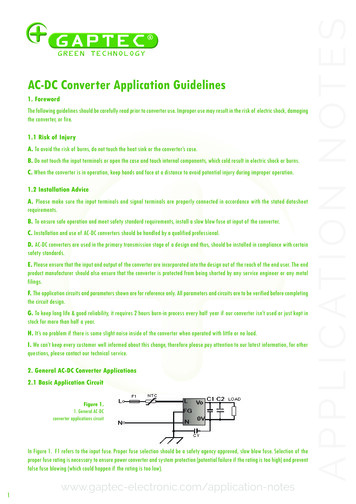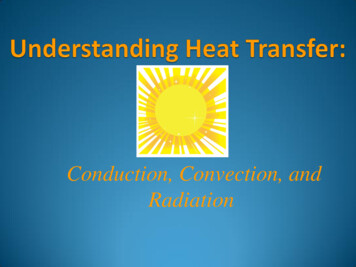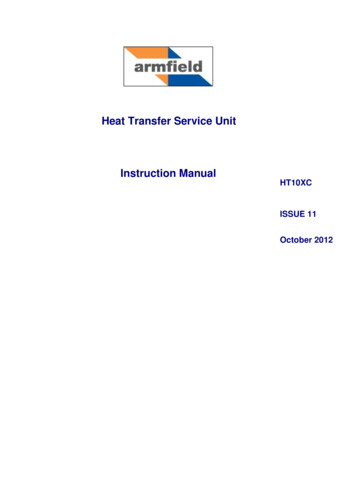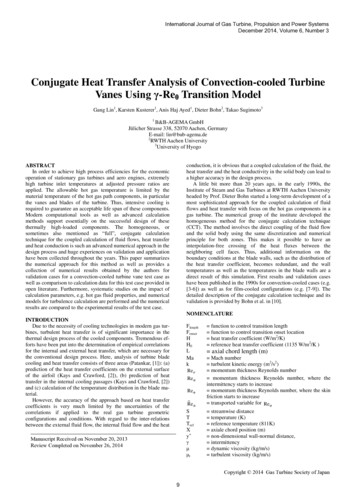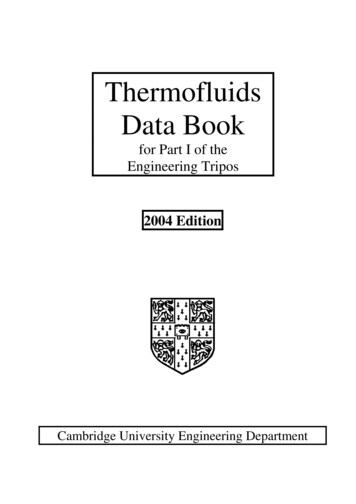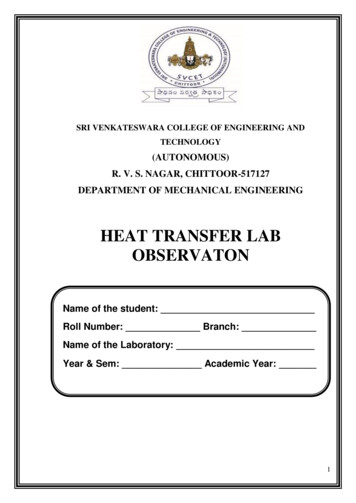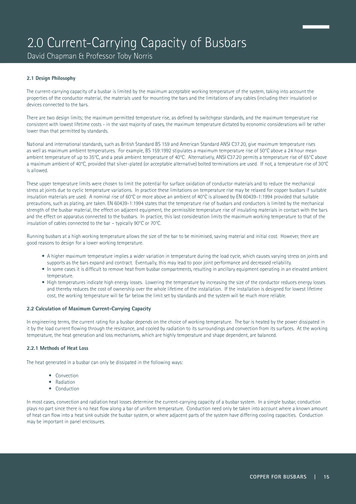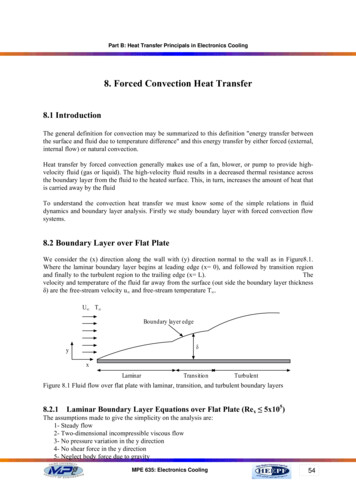
Transcription
Heat Convection
Latif M. JijiHeat ConvectionWith 206 Figures and 16 Tables
Prof. Latif M. JijiCity University of New YorkSchool of EngineeringDept. of Mechanical EngineeringConvent Avenue at 138th Street10031 New York, NYUSAE-Mail: jiji@ccny.cuny.eduLibrary of Congress Control Number: 2005937166ISBN-10 3-540-30692-7 Springer Berlin Heidelberg New YorkISBN-13 978-3-540-30692-4 Springer Berlin Heidelberg New YorkThis work is subject to copyright. All rights are reserved, whether the whole or part of the material isconcerned, specifically the rights of translation, reprinting, reuse of illustrations, recitation,broadcasting, reproduction on microfilm or in any other way, and storage in data banks. Duplicationof this publication or parts thereof is permitted only under the provisions of the German CopyrightLaw of September 9, 1965, in its current version, and permission for use must always be obtainedfrom Springer-Verlag. Violations are liable for prosecution under the German Copyright Law.Springer is a part of Springer Science Business Mediaspringer.com Springer-Verlag Berlin Heidelberg 2006Printed in The NetherlandsThe use of general descriptive names, registered names, trademarks, etc. in this publication does notimply, even in the absence of a specific statement, that such names are exempt from the relevantprotective laws and regulations and therefore free for general use.Cover Image: Microchannel convection, courtesy of Fluent Inc.Cover Design: Erich Kirchner, HeidelbergProduction: SPI Publisher Services, PondicherryPrinted on acid free paper30/3100/as543210
To my sister Sophie and brother Fouadfor their enduring love and affection
PREFACEWhy have I chosen to write a book on convection heat transfer whenseveral already exist? Although I appreciate the available publications, inrecent years I have not used a text book to teach our graduate course inconvection. Instead, I have relied on my own notes, not because existingtextbooks are unsatisfactory, but because I preferred to select and organizethe subject matter to cover the most basic and essential topics and to strikea balance between physical description and mathematical requirements. AsI developed my material, I began to distribute lecture notes to students,abandon blackboard use, and rely instead on PowerPoint presentations. Ifound that PowerPoint lecturing works most effectively when the presentedmaterial follows a textbook very closely, thus eliminating the need forstudents to take notes. Time saved by this format is used to raise questions,engage students, and gauge their comprehension of the subject. This bookevolved out of my success with this approach.This book is designed to:xxxxxxProvide students with the fundamentals and tools needed to model,analyze, and solve a wide range of engineering applications involvingconvection heat transfer.Present a comprehensive introduction to the important new topic ofconvection in microchannels.Present textbook material in an efficient and concise manner to becovered in its entirety in a one semester graduate course.Liberate students from the task of copying material from theblackboard and free the instructor from the need to prepare extensivenotes.Drill students in a systematic problem solving methodology withemphasis on thought process, logic, reasoning, and verification.Take advantage of internet technology to teach the course online byposting ancillary teaching materials and solutions to assignedproblems.
viiiHard as it is to leave out any of the topics usually covered in classictexts, cuts have been made so that the remaining materials can be taught inone semester. To illustrate the application of principles and the constructionof solutions, examples have been carefully selected, and the approach tosolutions follows an orderly method used throughout. To provideconsistency in the logic leading to solutions, I have prepared all solutionsmyself.This book owes a great deal to published literature on heat transfer. AsI developed my notes, I used examples and problems taken from publishedwork on the subject. As I did not always record references in my earlyyears of teaching, I have tried to eliminate any that I knew were not myown. I would like to express regret if a few have been unintentionallyincluded.Latif M. JijiNew York, New YorkJanuary 2006
CONTENTSPrefaceCHAPTER 1: BASIC 1Convection Heat TransferImportant Factors in Convection Heat TransferFocal Point in Convection Heat TransferThe Continuum and Thermodynamic Equilibrium ConceptsFourier’s Law of ConductionNewton’s Law of CoolingThe Heat Transfer Coefficient hRadiation: Stefan-Boltzmann LawDifferential Formulation of Basic LawsMathematical BackgroundUnitsProblem Solving Format11223568891213REFERENCESPROBLEMS1718CHAPTER 2: DIFFERENTIAL FORMULATION OF THEBASIC LAWS212.12.22.32.421212222IntroductionFlow GenerationLaminar vs. Turbulent FlowConservation of Mass: The Continuity Equation
x2.52.62.72.82.92.102.11Contents2.4.1 Cartesian Coordinates2.4.2. Cylindrical Coordinates2.4.3 Spherical CoordinatesConservation of Momentum: The Navier-Stokes Equations ofMotion2.5.1 Cartesian Coordinates2.5.2 Cylindrical Coordinates2.5.3 Spherical CoordinatesConservation of Energy: The Energy Equation2.6.1 Formulation: Cartesian Coordinates2.6.2 Simplified form of the Energy Equation2.6.3 Cylindrical Coordinates2.6.4 Spherical CoordinatesSolution to the Temperature DistributionThe Boussinesq ApproximationBoundary ConditionsNon-dimensional Form of the Governing Equations: Dynamicand Thermal Similarity Parameters2.10.1 Dimensionless Variables2.10.2 Dimensionless Form of Continuity2.10.3 Dimensionless Form of the Navier-Stokes Equations ofMotion2.10.4 Dimensionless Form of the Energy Equation2.10.5 Significance of the Governing Parameters2.10.6 Heat Transfer Coefficient: The Nusselt NumberScale 45464851525253535455596162CHAPTER 3: EXACT ONE-DIMENSIONAL SOLUTIONS693.13.23.3IntroductionSimplification of the Governing EquationsExact Solutions3.3.1 Couette Flow3.3.2 Poiseuille Flow3.3.3 Rotating Flow696971717786REFERENCESPROBLEMS9394
ContentsxiCHAPTER 4: BOUNDARY LAYER FLOW:APPLICATION TO EXTERNAL FLOW994.14.299994.34.4IntroductionThe Boundary Layer Concept: Simplification of theGoverning Equations4.2.1 Qualitative Description4.2.2 The Governing Equations4.2.3 Mathematical Simplification4.2.4 Simplification of the Momentum Equations4.2.5 Simplification of the Energy EquationSummary of Boundary Layer Equations for Steady LaminarFlowSolutions: External Flow4.4.1Laminar Boundary Layer Flow over Semi-infinite FlatPlate: Uniform Surface Temperature4.4.2 Applications: Blasius Solution, Pohlhausen’s Solution,and Scaling4.4.3 Laminar Boundary Layer Flow over Semi-infinite FlatPlate: Variable Surface Temperature4.4.4 Laminar Boundary Layer Flow over a Wedge:Uniform Surface 16131140143149150CHAPTER 5: APPROXIMATE SOLUTIONS: THEINTEGRAL 51681705.7IntroductionDifferential vs. Integral FormulationIntegral Method Approximation: Mathematical SimplificationProcedureAccuracy of the Integral MethodIntegral Formulation of the Basic Laws5.6.1 Conservation of Mass5.6.2 Conservation of Momentum5.6.3 Conservation of EnergyIntegral Solutions5.7.1 Flow Field Solution: Uniform Flow over a Semi-infinitePlate5.7.2 Temperature Solution and Nusselt Number:Flow over a Semi-infinite Plate170173
xiiContents5.7.3 Uniform Surface Flux185REFERENCESPROBLEMS193194CHAPTER 6: HEAT TRANSFER IN CHANNEL .66.76.8IntroductionHydrodynamic and Thermal Regions: General Features6.2.1 Flow Field6.2.2 Temperature FieldHydrodynamic and Thermal Entrance Lengths6.3.1 Scale Analysis6.3.2 Analytic and Numerical Solutions: Laminar FlowChannels with Uniform Surface Heat FluxChannels with Uniform Surface TemperatureDetermination of Heat Transfer Coefficient h(x) and NusseltNumber Nu D6.6.1 Scale Analysis6.6.2 Basic Considerations for the Analytical Determinationof Heat Flux, Heat Transfer Coefficient and NusseltNumberHeat Transfer Coefficient in the Fully Developed TemperatureRegion6.7.1 Definition of Fully Developed Temperature Profile6.7.2 Heat Transfer Coefficient and Nusselt Number6.7.3 Fully Developed Region for Tubes at Uniform SurfaceFlux6.7.4 Fully Developed Region for Tubes at Uniform SurfaceTemperature6.7.5 Nusselt Number for Laminar Fully Developed Velocityand Temperature in Channels of Various Cross-SectionsThermal Entrance Region: Laminar Flow Through Tubes6.8.1 Uniform Surface Temperature: Graetz Solution6.8.2 Uniform Surface Heat 242242252254255CHAPTER 7: FREE CONVECTION2597.1259Introduction
Contents7.27.37.47.57.67.7xiiiFeatures and Parameters of Free ConvectionGoverning Equations7.3.1 Boundary ConditionsLaminar Free Convection over a Vertical Plate:Uniform Surface Temperature7.4.1 Assumptions7.4.2 Governing Equations7.4.3 Boundary Conditions7.4.4 Similarity Transformation7.4.5 Solution7.4.6 Heat Transfer Coefficient and Nusselt NumberLaminar Free Convection over a Vertical Plate:Uniform Surface Heat FluxInclined PlatesIntegral Method7.7.1 Integral Formulation of Conservation of Momentum7.7.2 Integral Formulation of Conservation of Energy7.7.3 Integral Solution7.7.4 Comparison with Exact Solution for Nusselt 4264267267274279279279282283288CHAPTER 8: CORRELATION EQUATIONS:FORCED AND FREE ntroductionExperimental Determination of Heat Transfer Coefficient hLimitations and Accuracy of Correlation EquationsProcedure for Selecting and Applying Correlation EquationsExternal Forced Convection Correlations8.5.1 Uniform Flow over a Flat Plate: Transition to TurbulentFlow8.5.2 External Flow Normal to a Cylinder8.5.3 External Flow over a SphereInternal Forced Convection Correlations8.6.1 Entrance Region: Laminar Flow Through Tubes atUniform Surface Temperature8.6.2 Fully Developed Velocity and Temperature in Tubes:Turbulent Flow8.6.3 Non-circular Channels: Turbulent FlowFree Convection Correlations8.7.1 External Free Convection Correlations8.7.2 Free Convection in Enclosures296302303303303309310311311319
xiv8.8ContentsOther Correlations328REFERENCESPROBLEMS329331CHAPTER 9: CONVECTION IN MICROCHANNELS3439.1Introduction9.1.1 Continuum and Thermodynamic Hypothesis9.1.2 Surface Forces9.1.3 Chapter ScopeBasic Considerations9.2.1 Mean Free Path9.2.2 Why Microchannels?9.2.3 Classification9.2.4 Macro and Microchannels9.2.5 Gases vs. LiquidsGeneral Features9.3.1 Flow Rate9.3.2 Friction Factor9.3.3 Transition to Turbulent Flow9.3.4 Nusselt numberGoverning Equations9.4.1 Compressibility9.4.2 Axial Conduction9.4.3 DissipationVelocity Slip and Temperature Jump Boundary ConditionsAnalytic Solutions: Slip Flow9.6.1 Assumptions9.6.2 Couette Flow with Viscous Dissipation:Parallel Plates with Surface Convection9.6.3 Fully Developed Poiseuille Channel Flow: UniformSurface Flux9.6.4 Fully Developed Poiseuille Channel Flow:Uniform Surface Temperature9.6.5 Fully Developed Poiseuille Flow in Microtubes:Uniform Surface Flux9.6.6 Fully Developed Poiseuille Flow in Microtubes:Uniform Surface 69.29.39.49.59.6356368386391402
ContentsxvAPPENDIX AConservation of Energy: The Energy Equation413APPENDIX BPohlhausen’s Solution422APPENDIX CLaminar Boundary Layer Flow over Semiinfinite Plate: Variable Surface Temperature426APEENDIC DProperties of Dry Air at Atmospheric Pressure429APPENDIX EProperties of Saturated Water430INDEX431
1BASIC CONCEPTS1.1 Convection Heat TransferIn general, convection heat transfer deals with thermal interaction betweena surface and an adjacent moving fluid. Examples include the flow of fluidover a cylinder, inside a tube and between parallel plates. Convection alsoincludes the study of thermal interaction between fluids. An example is ajet issuing into a medium of the same or a different fluid.1.2 Important Factors in Convection Heat TransferConsider the case of the electric bulb shown inFig. 1.1. Surface temperature and heat fluxare Ts and q csc , respectively. The ambient fluidtemperature is Tf . Electrical energy is dissipated into heat at a fixed rate determined by thecapacity of the bulb. Neglecting radiation, thedissipated energy is transferred by convectionfrom the surface to the ambient fluid. Supposethat the resulting surface temperature is too highand that we wish to lower it. What are ouroptions?qcscTsxVfTf Fig. 1.1(1) Place a fan in front of the bulb and force theambient fluid to flow over the bulb.(2) Change the fluid, say, from air to a non-conducting liquid.(3) Increase the surface area by redesigning the bulb geometry.We conclude that three factors play major roles in convection heat transfer:(i) fluid motion, (ii) fluid nature, and (iii) surface geometry.Other common examples of the role of fluid motion in convection are:
21 Basic Conceptsx x x x Fanning to feel cool.Stirring a mixture of ice and water.Blowing on the surface of coffee in a cup.Orienting a car radiator to face air flow.Common to all these examples is a moving fluid which is exchanging heatwith an adjacent surface.1.3 Focal Point in Convection Heat TransferOf interest in convection heat transfer problems is the determination ofsurface heat transfer rate and/or surface temperature. These importantengineering factors are established once the temperature distribution in themoving fluid is determined. Thus the focal point in convection heat transferis the determination of the temperature distribution in a moving fluid. InCartesian coordinates this is expressed asTT ( x, y , z , t ) .(1.1)1.4 The Continuum and Thermodynamic Equilibrium ConceptsIn the previous sections we have invoked the concept of temperature andfluid velocity. The study of convection heat transfer depends on materialproperties such as density, pressure, thermal conductivity, and specificheat. These familiar properties which we can quantify and measure are infact manifestation of the molecular nature and activity of material. Allmatter is composed of molecules which are in a continuous state of randommotion and collisions. In the continuum model we ignore the characteristicsof individual molecules and instead deal with their average or macroscopiceffect. Thus, a continuum is assumed to be composed of continuous matter.This enables us to use the powerful tools of calculus to model and analyzephysical phenomena. However, there are conditions under which thecontinuum assumption breaks down. It is valid as long as there issufficiently large number of molecules in a given volume to make thestatistical average of their activities meaningful. A measure of the validityof the continuum assumption is the molecular-mean-free path O relative tothe characteristic dimension of the system under consideration. The meanfree-path is the average distance traveled by molecules before they collide.The ratio of these two length scales is called the Knudson number, Kn,defined as
1.5 Fourier’s Law of ConductionKnODe,3(1.2)where De is the characteristic length, such as the equivalent diameter orthe spacing between parallel plates. The criterion for the validity of thecontinuum assumption is [1]Kn 10 1 .(1.3a)Thus this assumption begins to break down, for example, in modelingconvection heat transfer in very small channels.Thermodynamic equilibrium depends on the collisions frequency ofmolecules with an adjacent surface. At thermodynamic equilibrium thefluid and the adjacent surface have the same velocity and temperature.This is called the no-velocity slip and no-temperature jump, respectively.The condition for thermodynamic equilibrium isKn 10 3 .(1.3b)The continuum and thermodynamic equilibrium assumptions will beinvoked throughout Chapters 1-8. Chapter 9, Convection in Microchannels,deals with applications where the assumption of thermodynamicequilibrium breaks down.1.5 Fourier’s Law of ConductionOur experience shows that if one end of a metal bar is heated, itstemperature at the other end will eventually begin to rise. This transfer ofenergy is due to molecular activity. Molecules at the hot end exchange theirkinetic and vibrational energies with neighboring layers through randommotion and collisions. A temperature gradient, or slope, is established withenergy continuously being transported in the direction of decreasingtemperature. This mode of energy transfer is called conduction. The samemechanism takes place in fluids, whether they are stationary or moving. Itis important to recognize that the mechanism for energy interchange at theinterface between a fluid and a surface is conduction. However, energytransport throughout a moving fluid is by conduction and convection.
41 Basic ConceptsWe now turn our attention toLformulating a law that will help usdetermine the rate of heat transfer byAconduction. Consider the wall shownin Fig.1.2 . The temperature of onesurface (x 0) is Tsi and of the othersurface (x L) is Tso . The wallthickness is L and its surface area isA. The remaining four surfaces areTsiTsowell insulated and thus heat isx0transferred in the x-direction only.dxAssume steady state and let q x bethe rate of heat transfer in the xFig. 1.2direction. Experiments have shownthat q x is directly proportional to Aand (Tsi Tso ) and inversely proportional to L. That isqx vqxA (Tsi Tso ).LIntroducing a proportionality constant k, we obtainqxkA (Tsi Tso ),L(1.4)where k is a property of material called thermal conductivity. We mustkeep in mind that (1.4) is valid for: (i) steady state, (ii) constant k and (iii)one-dimensional conduction.These limitations suggest that a reformulation is in order. Applying (1.4) to the element dx shown inFig.1.2 and noting that Tsi o T ( x), Tso o T ( x dx), and L is replacedby dx, we obtainqx k AT ( x dx) T ( x)T ( x) T ( x dx). k AdxdxSince T(x dx) T(x) dT, the above givesqx k AdT.dx(1.5)It is useful to introduce the term heat flux q cxc , which is defined as theheat flow rate per unit surface area normal to x. Thus,
1.6 Newton's Law of Coolingq cxcqx.A5(1.6)Therefore, in terms of heat flux, (1.5) becomesq cxc kdT.dx(1.7)Although (1.7) is based on one-dimensional conduction, it can begeneralized to three-dimensional and transient conditions by noting thatheat flow is a vector quantity. Thus, the temperature derivative in (1.7) ischanged to partial derivative and adjusted to reflect the direction of heatflow as follows:q cxc kwT,wxq cyc kwT,wyq czc kwT,wz(1.8)where x, y, and z are the rectangular coordinates. Equation (1.8) is knownas Fourier's law of conduction. Four observations are worth making: (i)The negative sign means that when the gradient is negative, heat flow is inthe positive direction, i.e., towards the direction of decreasing temperature,as dictated by the second law of thermodynamics. (ii) The conductivity kneed not be uniform since (1.8) applies at a point in the material and not toa finite region. In reality thermal conductivity varies with temperature.However, (1.8) is limited to isotropic material, i.e., k is invariant withdirection. (iii) Returning to our previous observation that the focal point inheat transfer is the determination of temperature distribution, we nowrecognize that once T(x,y,z,t) is known, the heat flux in any direction can beeasily determined by simply differentiating the function T and using (1.8).(iv) By manipulating fluid motion, temperature distribution can be altered.This results in a change in heat transfer rate, as indicated in (1.8).1.6 Newton's Law of CoolingAn alternate approach to determining heat transfer rate between a surfaceand an adjacent fluid in motion is based on Newton’s law of cooling. Usingexperimental observations by Isaac Newton, it is postulated that surfaceflux in convection is directly proportional to the difference in temperaturebetween the surface and the streaming fluid. That isq csc v Ts Tf ,
61 Basic Conceptswhere q csc is surface flux, Ts is surface temperature and Tf is the fluidtemperature far away from the surface. Introducing a proportionalityconstant to express this relationship as equality, we obtainq csch (Ts Tf ) .(1.9)This result is known as Newton's law of cooling. The constant ofproportionality h is called the heat transfer coefficient. This simple result isvery important, deserving special attention and will be examined in moredetail in the following section.1.7 The Heat Transfer Coefficient hThe heat transfer coefficient plays a major role in convection heat transfer.We make the following observations regarding h:(1) Equation (1.9) is a definition of h and not a phenomenological law.(2) Unlike thermal conductivity k, the heat transfer coefficient is not amaterial property. Rather it depends on geometry, fluid properties, motion,and in some cases temperature difference, 'T (Ts Tf ) . That ishf (geometry, fluid motion, fluid properties, 'T ) .(1.10)(3) Although no temperature distribution is explicitly indicated in (1.9), theanalytical determination of h requires knowledge of temperaturedistribution in a moving fluid.This becomes evident when bothFourier’s law and Newton’s laware combined. Application ofFourier’s law in the y-directionfor the surface shown in Fig. 1.3givesq csc kwT ( x,0, z ),wy(1.11)Fig. 1.3where y is normal to the surface, wT ( x,0, z ) / w y is temperature gradient inthe fluid at the interface, and k is the thermal conductivity of the fluid.Combining (1.9) and (1.11) and solving for h, gives
1.7 The Heat Transfer Coefficient hhwT ( x,0, z )wy. kTs Tf7(1.12)This result shows that to determine h analytically one must determinetemperature distribution.(4) Since both Fourier’s law and Newton’s law give surface heatflux, what is the advantage of introducing Newton’s law? In someapplications the analytical determination of the temperature distributionmay not be a simple task, for example, turbulent flow over a complexgeometry. In such cases one uses equation (1.9) to determine hexperimentally by measuring q csc , Ts and Tf and constructing an empiricalequation to correlate experimental data. This eliminates the need for thedetermination of temperature distribution.(5) We return now to the bulb shown in Fig. 1.1. Applying Newton’s law(1.9) and solving for surface temperature Ts , we obtainTsTf q csc.h(1.13)For specified q csc and Tf , surface temperature Ts can be altered bychanging h. This can be done by changing the fluid, surface geometryand/or fluid motion. On the other hand, for specified surface temperatureTs and ambient temperature Tf ,Table 1.1equation (1.9) shows that surfaceTypical values of hflux can be altered by changing h.2 o(6) One of the major objectives ofconvection is the determination of h.(7) Since h is not a property, itsvalues cannot be tabulated as is thecase with thermal conductivity,enthalpy, density, etc. Nevertheless,it is useful to have a rough idea ofits magnitude for common processesand fluids. Table 1.1 gives theapproximate range of h for variousconditions.ProcessFree convectionGasesLiquidsh ( W/m C)5-3020-1000Forced convectionGasesLiquidsLiquid metals20-30050-20,0005,000-50,000Phase 0
81 Basic Concepts1.8 Radiation: Stefan-Boltzmann LawRadiation energy exchange between two surfaces depends on the geometry,shape, area, orientation, and emissivity of the two surfaces. In addition, itdepends on the absorptivity D of each surface. Absorptivity is a surfaceproperty defined as the fraction of radiation energy incident on a surfacewhich is absorbed by the surface. Although the determination of the netheat exchange by radiation between two surfaces, q12 , can be complex, theanalysis is simplified for an ideal model for which the absorptivity D isequal to the emissivity H . Such an ideal surface is called a gray surface.For the special case of a gray surface which is completely enclosed by amuch larger surface, q12 is given by Stefan-Boltzmann radiation lawq12H 1V A1 (T14 T24 ) ,(1.14)where H 1 is the emissivity of the small surface, A1 its area, T1 its absolutetemperature, and T2 is the absolute temperature of the surrounding surface.Note that for this special case neither the area A2 of the large surface norits emissivity H 2 affect the result.1.9 Differential Formulation of Basic LawsThe analysis of convection heat transfer relies on the application of thethree basic laws: conservation of mass, momentum, and energy. Inaddition, Fourier’s conduction law and Newton’s law of cooling are alsoapplied. Since the focal point is the determination of temperaturedistribution, the three basic laws must be cast in an appropriate form thatlends itself to the determination of temperature distribution. This castingprocess is called formulation. Various formulation procedures areavailable. They include differential, integral, variational, and finitedifference formulation. This section deals with differential formulation.Integral formulation is presented in Chapter 5.Differential formulation is based on the key assumption of continuum.This assumption ignores the molecular structure of material and focuses onthe gross effect of molecular activity. Based on this assumption, fluids aremodeled as continuous matter. This makes it possible to treat variablessuch as temperature, pressure, and velocity as continuous function in thedomain of interest.
1.10 Mathematical Background1.10 Mathematical BackgroundyWe review the following mathematicaldefinitions which are needed in the differentialformulation of the basic laws.&Vu i v j wk .vuw&(a) Velocity Vector V . Let u, v, and w be thevelocity components in the& x, y and z directions,respectively. The vector V is given by9xz(1.15a)Fig. 1.4(b) Velocity Derivative. The derivative of the velocity vector with respectto any one of the three independent variables is given by&wVwxwuwvwwi j k.wxwxwx(1.15b)(c) The Operator . In Cartesian coordinates the operator is a vectordefined as {wwwi j k.wxwywz(1.16)In cylindrical coordinates this operator takes the following form {ww1 wir iT i z .wrr wTwz(1.17)Similarly, the form in spherical coordinate is {1 w1wwir iT iI .r wTr sin T wIwr(1.18)&(d) Divergence of a Vector. The divergence of a vector V is a scalardefined as&&div.V { Vwu wv ww. wx wy wz(1.19)
101 Basic Concepts(e) Derivative of the Divergence. The derivative of the divergence withrespect to any one of the three independent variables is given by&w Vwxw § wu wv ww · . wx wx wy wz ¹(1.20)The right hand side of (1.20) represents the divergence of the derivative of&the vector V . Thus (1.20) can be rewritten as&w Vwx wui v j wk ,wxor&w Vwx&wV .wx(1.21)(f) Gradient of Scalar. The gradient of a scalar, such as temperature T, is avector given byGrad T { TwTwTwTi j k.wzwxwy(1.22)(g) Total Differential and Total Derivative. We consider a variable ofthe flow field designated by the symbol f. This is a scalar quantity such astemperature T, pressure p, density U , or velocity component u. In generalthis quantity is a function of the four independent variables x, y, z and t.Thus in Cartesian coordinates we writeff ( x, y , z , t ) .(a)The total differential of f is the total change in f resulting from changes inx, y, z and t. Thus, using (a)dfDividing through by dtwfwfwfwfdx dy dz dt .wtwzwywx
1.10 Mathematical Backgroundwf dx wf dy wf dz wf .wx dt wy dt wz dt tuting (c) into (b)dfdtDfDtuwf wfwfwf. w vwz wtwywx(1.23)df / dt in the above is called the total derivative. It is also written asDf / Dt , to emphasize that it represents the change in f which resultsfrom changes in the four independent variables. It is also referred to as thesubstantial derivative. Note that the first three terms on the right hand sideare associated with motion and are referred to as the convective derivative.The last term represents changes in f with respect to time and is called thelocal derivative. Thusuwfwfwf w vwzwywxwfwtconvective derivative,(d)local derivative.(e)To appreciate the physical significance of (1.23), we apply it to the velocitycomponent u. Setting f u in (1.23) givesdudtDuDtuwu wuwuwu. w vwz wtwywx(1.24)Following (d) and (e) format, (1.24) representsuwuwuww v wwxwywzconvective acceleration in the x-direction,(f)
121 Basic Conceptswulocal acceleration .wt(g)Similarly, (1.23) can be applied to the y and z directions to obtain thecorresponding total acceleration in these directions.The three components of the total acceleration in the cylindricalcoordinates r ,T , z aredv rdtdvTdtDv rDtDvTDtdv zdtwvwvwv r vT wv r vT2 v z r r , (1.25a) r wTrwtwzwrvrvrDv zDtwvwvwvT vT wvT v r vT v z T T , (1.25b) wzwrr wTrwtvrwv z vT wv zwvwv vz z z .wrwzr wTwt(1.25c)Another example of total derivative is obtained by setting f T in(1.23) to obtain the total temperature derivativedTdtDTDtuwTwTwT wT v w. wxwywz wt(1.26)1.11 UnitsSI units are used throughout this text. The basic units in this system are:Length (L): meter (m).Time (t): second (s).Mass (m): kilogram (kg).Temperature (T): kelvin (K).Temperature on the Celsius scale is related to the kelvin scale byT(oC) T(K) - 273.15.(1.27)Note that temperature difference on the two scales is identical. Thus, achange of one kelvin is equal to a change of one Celsius. This means thatquantities that are expressed per unit kelvin, such as thermal conductivity,
1.12 Problem Solving Format13heat transfer coefficient, and specific heat, are numerically the same as perdegree Celsius. That is, W/m2-K W/ m2-oC.The basic units are used
1.1 Convection Heat Transfer 1 1.2 Important Factors in Convection Heat Transfer 1 1.3 Focal Point in Convection Heat Transfer 2 1.4 The Continuum and Thermodynamic Equilibrium Concepts 2 1.5 Fourier’s Law of Conduction 3 1.6 Newton

